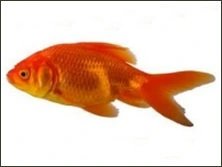- Home
- Disease Causes
- Common Goldfish Diseases
- Goldfish Lice Treatment
Goldfish Lice Treatment
Lice are free swimming crustaceans that attach themselves to fish and feed on their blood.
 Female Louse (Argulus trilineatus)
Female Louse (Argulus trilineatus)Goldfish lice (Argulus trilineatus) are a member of the Copepod family, so are not actually lice at all but crustaceans.
Fully grown they are 3-7mm long and 2-4mm wide and translucent. This makes them quite hard to see as they fasten themselves flat against the body of their host. The female (shown) is slightly larger than the male.
Adults use sucker-like mouths, and juveniles use hooks on their legs to attach themselves to a host; they then use a proboscis to inject enzymes into the host to break down the tissue and blood for easier extraction.
A heavy infestation can weaken a Goldfish from blood loss to the point where it will die.
Signs of infestation are when fish are seen rubbing themselves vigorously against any available object in the pond or aquarium. This behavior often causes injury to scales and fins and is more dangerous to the fish than the lice themselves.
Goldfish Lice Sources
Infested fish introduced into the pond or aquarium is an obvious source, but plants gathered from the wild that haven’t been sterilized are often the culprit.
Lice Life Cycle
Lice only require one host to develop from the egg stage through to an egg-laying adult.
The female can lay up to 2000 eggs in rows on hard surfaces in the aquarium or pond and are surrounded by a clear gelatinous material. This gelatinous material protects the eggs from predation and stops any water-borne treatments from reaching them, making it difficult to remove or kill them once they are laid.
Water temperature governs the hatching time; below 10oC (50oF) hatching is delayed, and depending on species, at 15oC (59oF) the eggs hatch between 25-61 days.
The eggs are able to withstand low winter temperatures by lying dormant until temperatures rise above 10oC (50oF). Juveniles can also winter over in a host fish’s slime coating.
After hatching into the metanauplius stage, the larvae must find a host fish within 2-3 days. After attaching to a host the larvae change into the juvenile stage which is when the parasite starts feeding on the host’s blood. There are multiple juvenile stages when molting of the outer surface or exoskeleton occurs, the frequency depending on which species of lice it is.
Depending on species and water temperature, within a few weeks, the parasite develops into an adult that lives between 30-100 days.
After mating has taken place the female detaches from the host and becomes free swimming to lay her eggs.
Once the female has laid her eggs, she returns to a host fish. Adult lice can survive off a host for about two weeks.
Lice multiply rapidly during summer and reach their highest densities in late autumn.
Goldfish Lice Treatment Options
Treating Aquariums
A safe and convenient treatment to use is a medication specifically made for parasitic crustaceans such as Ecological Labs LAWP16 Microbe Lift Lice and Anchor Worm treatment.
As stated on the bottle, this medication will also treat anchor worm which is a convenient bonus but not surprising as both are crustaceans.
Follow the manufacturer's instructions and monitor your goldfish carefully for signs of toxic reaction such as lethargy, gasping at the surface or turning on its side.
Microbe-Lift must not be used with crayfish, shrimp, or other crustaceans.
Another treatment option available, especially if the infestation is only one or two lice, is dabbing the louse with a cotton bud that has been dipped in a 50/50 solution of Kerosene and Turpentine. Be careful not to get any of the solution into the gills, mouth or eyes of the fish.
The louse may still need to be removed with tweezers.
Sterilize the aquarium completely (including plants) to kill any adults or nauplii.
Once the lice drop off the Goldfish move the fish into a mild salt bath of two teaspoons per gallon of Aquarium Salt for a couple of days.
Treating Ponds
Dipterex (Dylox neguvon) is also effective in combating lice.
It is an insecticide that is soluble in water, comes in liquid or powder form and comes in different potencies ranging from 40 to 98%.
Try and find Dipterex with 98% potency as the doses below are based on this potency level. If you can only find lower potency levels, you will have to calculate how much you need based on the doses below.
The treatments for pond and aquarium are different, but the dosage is the same for each. Below are several measurement options:
Dipterex Dosage
- 1 part Dipterex to 3-5 million parts water or
- 1 milliliter to 660 -1100 Imp gallons of water or
- 1 milliliter to 790 - 1320 US gallons of water.
Be accurate with measuring the dose because above 1.60 ppm Dipterex is acutely toxic to fish. For freshwater invertebrates it is toxic in ppb (parts per billion) so dose on the low side rather than the high.
Precaution
Do not treat when water temperatures are below 18oC (64oF) as fish cannot metabolize/excrete it fast enough.
Do not treat when water temperatures are above 28oC (82oF) as fish uptake rate is too high.
Treat the pond three times at 7 day intervals.
There should be some form of water circulation to spread the Dipterex evenly throughout the pond.
Dipterex isn’t stable in water and breaks down after a few days. The lice eggs survive the treatment but emerging parasites are killed by the follow-up treatments.
Top of Goldfish Lice Treatment page









